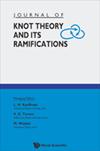吉川表中面链的三点数
IF 0.4
4区 数学
Q4 MATHEMATICS
引用次数: 0
摘要
吉川在R^4中做了一个表,上面有结面,ch-index小于等于10。这个引人注目的表是第一个列举类似于经典素数结表的结面。曲面连杆的破页图是曲面在R^3中的一般投影,其奇异集上有交叉信息。在表示给定表面结的所有破片图中,三点数的最小值就是它的三点数。本文编制了吉川表中已知的表面连杆的三点数,并计算或提供了剩余表面连杆的三点数的边界。本文章由计算机程序翻译,如有差异,请以英文原文为准。
On the Triple Point Number of Surface-Links in Yoshikawa's Table
Yoshikawa made a table of knotted surfaces in R^4 with ch-index 10 or less. This remarkable table is the first to enumerate knotted surfaces analogous to the classical prime knot table. A broken sheet diagram of a surface-link is a generic projection of the surface in R^3 with crossing information along its singular set. The minimal number of triple points among all broken sheet diagrams representing a given surface-knot is its triple point number. This paper compiles the known triple point numbers of the surface-links represented in Yoshikawa's table and calculates or provides bounds on the triple point number of the remaining surface-links.
求助全文
通过发布文献求助,成功后即可免费获取论文全文。
去求助
来源期刊
CiteScore
0.80
自引率
40.00%
发文量
127
审稿时长
4-8 weeks
期刊介绍:
This Journal is intended as a forum for new developments in knot theory, particularly developments that create connections between knot theory and other aspects of mathematics and natural science. Our stance is interdisciplinary due to the nature of the subject. Knot theory as a core mathematical discipline is subject to many forms of generalization (virtual knots and links, higher-dimensional knots, knots and links in other manifolds, non-spherical knots, recursive systems analogous to knotting). Knots live in a wider mathematical framework (classification of three and higher dimensional manifolds, statistical mechanics and quantum theory, quantum groups, combinatorics of Gauss codes, combinatorics, algorithms and computational complexity, category theory and categorification of topological and algebraic structures, algebraic topology, topological quantum field theories).
Papers that will be published include:
-new research in the theory of knots and links, and their applications;
-new research in related fields;
-tutorial and review papers.
With this Journal, we hope to serve well researchers in knot theory and related areas of topology, researchers using knot theory in their work, and scientists interested in becoming informed about current work in the theory of knots and its ramifications.

 求助内容:
求助内容: 应助结果提醒方式:
应助结果提醒方式:


